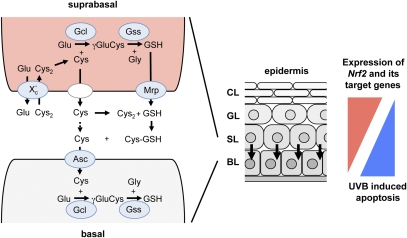Figure 6.
Model describing biosynthesis and recycling of GSH in the epidermis. (Middle) Scheme of the murine epidermis with basal, spinous, granular, and cornified layers. Arrows indicate a postulated paracrine cytoprotection of basal keratinocytes by suprabasal keratinocytes. (Left) Paracrine action of GSH and cysteine (Cys) involving suprabasal and basal layers. GSH is synthesized in a two-step reaction catalyzed by the enzymes Gcl and Gss. Extracellular cystine (Cys2), the oxidized (predominant extracellular) form of cysteine, is imported into suprabasal cells by the antiporter xc−. Intracellular cystine is reduced to cysteine, which is the rate-limiting amino acid for GSH synthesis. Cysteine as well as GSH are subsequently exported by suprabasal keratinocytes. GSH export occurs via Mrp transporters. Extracellular GSH provides cysteine via a thiol exchange reaction with cystine. Extracellular cysteine can be imported directly by basal keratinocytes via the importer Asc to serve as substrate for GSH synthesis in basal keratinocytes. Genes activated by Nrf2 in keratinocytes are encircled and highlighted with blue. (Right) A suprabasal-to-basal gradient of Nrf2 and its target genes coding for ROS-detoxifying enzymes and antioxidant proteins (in red) control UVB-induced apoptosis in the murine epidermis, resulting in an antagonistic basal-to-suprabasal gradient of apoptosis (in blue).

